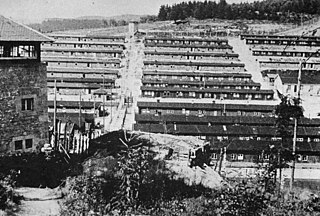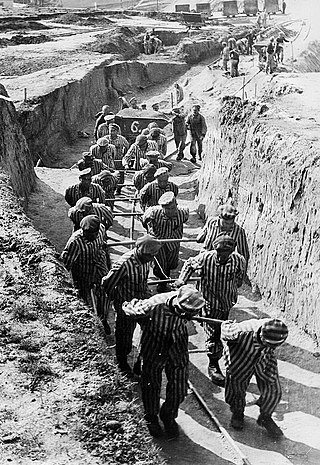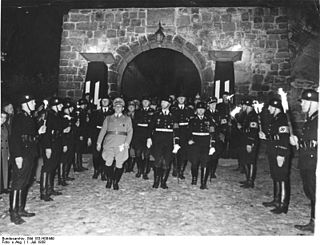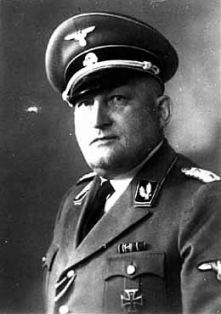Related Research Articles

Sonderkommandos were work units made up of German Nazi death camp prisoners. They were composed of prisoners, usually Jews, who were forced, on threat of their own deaths, to aid with the disposal of gas chamber victims during the Holocaust. The death-camp Sonderkommandos, who were always inmates, were unrelated to the SS-Sonderkommandos, which were ad hoc units formed from members of various SS offices between 1938 and 1945.

Flossenbürg was a Nazi concentration camp built in May 1938 by the SS Main Economic and Administrative Office. Unlike other concentration camps, it was located in a remote area, in the Fichtel Mountains of Bavaria, adjacent to the town of Flossenbürg and near the German border with Czechoslovakia. The camp's initial purpose was to exploit the forced labor of prisoners for the production of granite for Nazi architecture. In 1943, the bulk of prisoners switched to producing Messerschmitt Bf 109 fighter planes and other armaments for Germany's war effort. Although originally intended for "criminal" and "asocial" prisoners, after Germany's invasion of the Soviet Union, the camp's numbers swelled with political prisoners from outside Germany. It also developed an extensive subcamp system that eventually outgrew the main camp.

Theodor Eicke was a senior SS functionary and Waffen SS divisional commander during the Nazi era. He was one of the key figures in the development of Nazi concentration camps. Eicke served as the second commandant of the Dachau concentration camp from June 1933 to July 1934, and together with his adjutant Michael Lippert, was one of the executioners of SA Chief Ernst Röhm during the Night of the Long Knives purge of 1934. He continued to expand and develop the concentration camp system as the first Concentration Camps Inspector.

Oswald Ludwig Pohl was a German SS functionary during the Nazi era. As the head of the SS Main Economic and Administrative Office and the head administrator of the Nazi concentration camps, he was a key figure in the Final Solution, the genocide of the European Jews. After the war, Pohl went into hiding; he was apprehended in 1946. Pohl stood trial in 1947, was convicted of crimes against humanity, and sentenced to death. After repeatedly appealing his case, he was executed by hanging in 1951.

From 1933 to 1945, Nazi Germany operated more than a thousand concentration camps, including subcamps on its own territory and in parts of German-occupied Europe.

The Allgemeine SS was a major branch of the Schutzstaffel (SS) paramilitary forces of Nazi Germany; it was managed by the SS Main Office (SS-Hauptamt). The Allgemeine SS was officially established in the autumn of 1934 to distinguish its members from the SS-Verfügungstruppe, which later became the Waffen-SS, and the SS-Totenkopfverbände, which were in charge of the Nazi concentration camps and extermination camps. SS formations committed many war crimes against civilians and allied servicemen.

Richard Glücks was a high-ranking German Nazi official in the SS. From November 1939 until the end of World War II, he was Concentration Camps Inspector (CCI), which became Amt D: Konzentrationslagerwesen under the WVHA in Nazi Germany. As a direct subordinate of Heinrich Himmler, he was responsible for the forced labour of the camp inmates, and was also the supervisor for the medical practices in the camps, ranging from human experimentation to the implementation of the "Final Solution", in particular the mass murder of inmates with Zyklon B gas. After Germany capitulated, Glücks committed suicide by swallowing a potassium cyanide capsule.

Extermination through labour is a term that was adopted to describe forced labor in Nazi concentration camps in light of the high mortality rate and poor conditions; in some camps a majority of prisoners died within a few months. In the 21st century, research has questioned whether there was a general policy of extermination through labor in the Nazi concentration camp system because of widely varying conditions between camps. German historian Jens-Christian Wagner argues that the camp system involved the exploitation of forced labor of some prisoners and the systematic murder of others, especially Jews, with only limited overlap between these two groups.

The SS Main Economic and Administrative Office was a Nazi organization responsible for managing the finances, supply systems and business projects of the Allgemeine-SS. It also ran the concentration camps and was instrumental in the implementation of the Final Solution through such subsidiary offices as the Concentration Camps Inspectorate and SS camp guards.

The Concentration Camps Inspectorate (CCI) or in German, IKL was the central SS administrative and managerial authority for the concentration camps of the Third Reich. Created by Theodor Eicke, it was originally known as the "General Inspection of the Enhanced SS-Totenkopfstandarten", after Eicke's position in the SS. It was later integrated into the SS Main Economic and Administrative Office as "Amt D".

Subcamps, officially Arbeitslager der Waffen-SS, were outlying detention centres (Haftstätten) that came under the command of a main concentration camps run by the SS in Nazi Germany and German-occupied Europe. The Nazis distinguished between the main camps and the subcamps subordinated to them. Survival conditions in the subcamps were, in many cases, poorer for the prisoners than those in the main camps.

Jane Caplan is an academic and historian specialising in Nazi Germany and the history of the documentation of individual identity. She is currently Visiting Professor at Birkbeck, University of London, Visiting Professor of History at Gresham College and Emeritus Fellow at St. Antony's College, University of Oxford.
Stanisław Kłodziński (1918–1990) was a Polish physician, lung specialist, and survivor of the Auschwitz concentration camp. He became known for his writing about Auschwitz, and in particular for having co-founded the Zeszyty Oświęcimskie in 1961, devoted to discussing the camp.
Nikolaus Daniel Wachsmann is a professor of modern European history in the Department of History, Classics and Archaeology at Birkbeck College, University of London.
In Nazi Germany, the Standarte was a paramilitary unit of Nazi Party (NSDAP), Sturmabteilung (SA), NSKK, NSFK, and Schutzstaffel (SS). Translated literally as "Regimental standard", the name refers to the flag paramilitary formations carried in formations and parades.

KL: A History of the Nazi Concentration Camps is a 2015 book by Birkbeck College professor Nikolaus Wachsmann.

The early camps were extrajudicial sites of detention established in Nazi Germany in 1933. Although the system was mostly dismantled by the end of the year, these camps were the precursor of the Nazi concentration camps.
The Business of Genocide: The SS, Slave Labor, and the Concentration Camps is a book by Michael Thad Allen which focuses on the SS Main Economic and Administrative Office and its role in the Nazi concentration camps and slave labor of Nazi Germany.

Forced labor was an important and ubiquitous aspect of the Nazi concentration camps which operated in Nazi Germany and German-occupied Europe between 1933 and 1945. It was the harshest and most inhumane part of a larger system of forced labor in Nazi Germany.

Private sector participation in Nazi crimes was extensive and included widespread use of forced labor in Nazi Germany and German-occupied Europe, confiscation of property from Jews and other victims by banks and insurance companies, and the transportation of people to Nazi concentration camps and extermination camps by rail. After the war, companies sought to downplay their participation in crimes and claimed that they were also victims of Nazi totalitarianism. However, the role of the private sector in Nazi Germany has been described as an example of state-corporate crime.
References
- ↑ Schulte, Jan Erik (3 November 2011). "Jane Caplan and Nikolaus Wachsmann (eds)". Journal of Contemporary History. 46 (4): 942–945. doi:10.1177/0022009411413861c. S2CID 159546145.
- ↑ Hajkova, A. (17 November 2010). "Concentration Camps in Nazi Germany: The New Histories". German History. 29 (3): 533–535. doi:10.1093/gerhis/ghq128.
- ↑ Walker, Mark (5 September 2011). "Concentration Camps in Nazi Germany: The New Histories. Edited by Jane Caplan and Nikolaus Wachsmann. London: Routledge. 2010. Pp. xi + 243. Cloth $117.00. ISBN 13: 978-0415426503. Paper $35.95. ISBN 978-0-415-42651-0". Central European History. 44 (3): 577–580. doi:10.1017/S0008938911000574. S2CID 145262011.